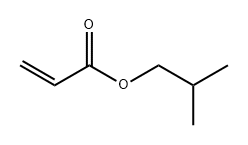2-Methylpropylacrylat
|
|
2-Methylpropylacrylat Eigenschaften
- Schmelzpunkt:
- -60°C
- Siedepunkt:
- 132 °C (lit.)
- Dichte
- 0.89 g/mL at 25 °C (lit.)
- Dampfdruck
- 8.13hPa at 22.9℃
- Brechungsindex
- n
20/D 1.414(lit.)
- Flammpunkt:
- 91 °F
- L?slichkeit
- soluble in Ether,Alcohol
- Aggregatzustand
- clear liquid
- Farbe
- Colorless to Almost colorless
- Geruch (Odor)
- Sharp, fragrant.
- Odor Threshold
- 0.0009ppm
- Wasserl?slichkeit
- 7.903g/L(temperature not stated)
- BRN
- 1749388
- Stabilit?t:
- Stability Heat and light sensitive. Susceptible to polymerisation. Flammable. Incompatible with strong oxidizing agents, aldehydes.
- LogP
- 2.220
- CAS Datenbank
- 106-63-8(CAS DataBase Reference)
- NIST chemische Informationen
- 2-Propenoic acid, 2-methylpropyl ester(106-63-8)
- EPA chemische Informationen
- Isobutyl acrylate (106-63-8)
Sicherheit
- Risiko- und Sicherheitserkl?rung
- Gefahreninformationscode (GHS)
| Kennzeichnung gef?hrlicher | Xn | ||
|---|---|---|---|
| R-S?tze: | 10-20/21-38-43-37/38 | ||
| S-S?tze: | 9-24-37 | ||
| RIDADR | UN 2527 3/PG 3 | ||
| WGK Germany | 2 | ||
| RTECS-Nr. | AT2100000 | ||
| TSCA | Yes | ||
| HazardClass | 3 | ||
| PackingGroup | III | ||
| HS Code | 29161230 | ||
| Giftige Stoffe Daten | 106-63-8(Hazardous Substances Data) |
| Bildanzeige (GHS) |
 
|
||||||||||||||||||||||||||||||||||||||||||
|---|---|---|---|---|---|---|---|---|---|---|---|---|---|---|---|---|---|---|---|---|---|---|---|---|---|---|---|---|---|---|---|---|---|---|---|---|---|---|---|---|---|---|---|
| Alarmwort | Warnung | ||||||||||||||||||||||||||||||||||||||||||
| Gefahrenhinweise |
|
||||||||||||||||||||||||||||||||||||||||||
| Sicherheit |
|
2-Methylpropylacrylat Chemische Eigenschaften,Einsatz,Produktion Methoden
R-S?tze Betriebsanweisung:
R10:Entzündlich.R20/21:Gesundheitssch?dlich beim Einatmen und bei Berührung mit der Haut.
R38:Reizt die Haut.
R43:Sensibilisierung durch Hautkontakt m?glich.
S-S?tze Betriebsanweisung:
S9:Beh?lter an einem gut gelüfteten Ort aufbewahren.S24:Berührung mit der Haut vermeiden.
S37:Geeignete Schutzhandschuhe tragen.
Chemische Eigenschaften
Liquid.Contains 100 ppm monomethyl ether hydroquinone as inhibitor.Verwenden
Isobutyl Acrylate is used in of acrylic acid metal salt resin with good antifouling performance.Allgemeine Beschreibung
A clear colorless liquid with an acrid odor. Flash point 86°F. Less dense than water. Vapors irritate eyes and respiratory system. May polymerize exothermically if heated or contaminated. If polymerization takes place inside a container, the container may rupture violently.Air & Water Reaktionen
Highly flammable. Slightly soluble in waterReaktivit?t anzeigen
Isobutyl acrylate is an ester. Esters react with acids to liberate heat along with alcohols and acids. Strong oxidizing acids may cause a vigorous reaction that is sufficiently exothermic to ignite the reaction products. Heat is also generated by the interaction of esters with caustic solutions. Flammable hydrogen is generated by mixing esters with alkali metals and hydrides. Polymerizes readily in the presence of heat and light generating much heat; reacts with strong oxidants. REF [Handling Chemicals Safely, 1980. p. 235].Hazard
Flammable, moderate fire risk.Health Hazard
Moderate toxicity when swallowed. Contact with the eyes causes minor irritation no worse than that caused by hand soap.Brandgefahr
HIGHLY FLAMMABLE: Will be easily ignited by heat, sparks or flames. Vapors may form explosive mixtures with air. Vapors may travel to source of ignition and flash back. Most vapors are heavier than air. They will spread along ground and collect in low or confined areas (sewers, basements, tanks). Vapor explosion hazard indoors, outdoors or in sewers. May polymerize explosively when heated or involved in a fire. Runoff to sewer may create fire or explosion hazard. Containers may explode when heated. Many liquids are lighter than water.Chemische Reaktivit?t
Reactivity with Water No reaction; Reactivity with Common Materials: No reactions; Stability During Transport: Stable; Neutralizing Agents for Acids and Caustics: Not pertinent; Polymerization: Polymerizes upon exposure to heat; uncontrolled bulk polymerization can be explosive; Inhibitor of Polymerization: Methyl ether of hydroquinone: 10 - 100 ppm; Hydroquinone: 5 ppm.2-Methylpropylacrylat Upstream-Materialien And Downstream Produkte
Upstream-Materialien
Downstream Produkte
2-Methylpropylacrylat Anbieter Lieferant Produzent Hersteller Vertrieb H?ndler.
Global( 159)Lieferanten
| Firmenname | Telefon | Land | Produktkatalog | Edge Rate | |
|---|---|---|---|---|---|
| Hebei Weibang Biotechnology Co., Ltd | +8615531157085 |
abby@weibangbio.com | China | 8806 | 58 |
| Hebei Mujin Biotechnology Co.,Ltd | +86 13288715578 +8613288715578 |
sales@hbmojin.com | China | 12831 | 58 |
| Henan Fengda Chemical Co., Ltd | +86-371-86557731 +86-13613820652 |
info@fdachem.com | China | 20267 | 58 |
| Henan Tianfu Chemical Co.,Ltd. | +86-0371-55170693 +86-19937530512 |
info@tianfuchem.com | China | 21634 | 55 |
| Hefei TNJ Chemical Industry Co.,Ltd. | +86-0551-65418679 +8618949832763 |
info@tnjchem.com | China | 2986 | 55 |
| SHANDONG ZHI SHANG CHEMICAL CO.LTD | +86 18953170293 |
sales@sdzschem.com | China | 2930 | 58 |
| Hubei Jusheng Technology Co.,Ltd. | 18871490254 |
linda@hubeijusheng.com | CHINA | 28172 | 58 |
| Hubei xin bonus chemical co. LTD | 86-13657291602 |
linda@hubeijusheng.com | CHINA | 22963 | 58 |
| Shandong chuangyingchemical Co., Ltd. | 18853181302 |
sale@chuangyingchem.com | CHINA | 5906 | 58 |
| Career Henan Chemica Co | +86-0371-86658258 +8613203830695 |
laboratory@coreychem.com | China | 30236 | 58 |
106-63-8(2-Methylpropylacrylat)Verwandte Suche:
tert-Butylacrylat
Dimethylsuccinat
tert-Butylmethacrylat
Butyloleat
Butylacrylat
Tris(trimethylsilyl)phosphat
FEMA 2816
Methylacrylat
2-Propens?ure
Isobutylphenylacetat
Isobutylacetat
Butylmethacrylat
POLY(ISOBUTYL METHACRYLATE)
Isobutylcinnamat
2-Ethyl-2-[[(1-oxoallyl)oxy]methyl]-1,3-propandiyldiacrylat
β-D-Glucopyranosid, 1a,1b,2,5a,6,6a-Hexahydro-6-hydroxy-1a-(hydroxymethyl)oxireno[4,5]cyclopenta[1,2-c]pyran-2-yl, 6-(3-Phenyl-2-propenoat), [1aS-[1aα,1bβ,2β(E),5aβ,6β,6aα-
Propylidintrimethyltrimethacrylat
Isobutylmethacrylat
- 2-propenoicacid,isobutylester
- 2-propenoicacidisobutylester
- ISOBUTYL ACRYLATE, 99+%
- ISOBUTYL ACRYLATE, STAB.
- Isobutylacrylat
- Isobutyl acrylate, 99%, stab. with 100ppm 4-methoxyphenol
- Isobutyl Acrylate (stabilized with MEHQ)
- Acrylic acid isobutyl
- Propenoic acid 2-methylpropyl ester
- Isobutyl Acrylate
- Isobutyl Acrylate (stabilized with MEHQ), 99.0%(GC)
- Isobutyl acrylate >=99%, contains 10-20 ppm monomethyl ether hydroquinone as inhibitor
- Isobutyl acrylate, stabilized with 100ppm 4-methoxyphenol
- acrylated’isobutyle
- Isobutyl 2-propenoate
- Isobutyl acrylate, inhibited
- Isobutyl propenoate
- isobutyl2-propenoate
- Isobutylester kyseliny akrylove
- isobutylesterkyselinyakrylove
- propenoicacid,isobutylester
- z-Methylpropyl acrylate
- ISOBUTYL ACRYLATE
- ACRYLIC ACID ISOBUTYL ESTER
- Isobutyl acrylate, 99%, stabilized with 100 ppm MEHQ
- ISOBUTYL ACRYLATE/IBA
- Isobutyl Acrylate (stabilized with MEHQ)>
- 2-methylpropylacrylate
- 2-methylpropyl prop-2-enoate
- isobutylpropenoate
- IBA
- 106-63-8
- CH2CHCO2CH2CHCH32
- CH2CHCOOCH2CHCH32
- 106638
- C6 to C7
- Carbonyl Compounds
- ACRYLIC
- Building Blocks
- Organic Building Blocks
- Esters
- AcrylateCarbonyl Compounds
- Acrylic Monomers
- Monomers
- C6 to C7
- Carbonyl Compounds
- Esters







